Night terrors in babies: don't panic!

Night terrors in children can be truly alarming!
They usually occur early in the night and are marked by a child screaming, crying out, or shouting with no awareness of their surroundings. Their heart rate speeds up, breathing becomes rapid, and they may appear agitated or sweaty.
And yet, just a few minutes later, your little one gently drifts back to sleep. The next morning, they have no memory of what happened during the night.
Don't worry! While unsettling for parents, these episodes are actually quite common in children between 18 months and 4 years old.
Up to 40% of toddlers experience these so-called “night terrors.”
So what should you do when this happens? What’s the right way to respond? Let’s take a closer look at how to handle night terrors in young children.
Recognizing Night Terrors in Children
Night terrors are one of the most intense sleep disturbances you can witness in a child. There’s no missing them — the screams can echo throughout the entire house. This condition falls under the category of parasomnias and shares similarities with sleepwalking.
Your child is completely unaware of their surroundings and of you, even if their eyes are open. They won’t respond to your voice or touch. Typically, they fall back asleep within 5 to 10 minutes without any trouble. These episodes usually occur in the first part of the night, right after your child completes a cycle of deep sleep.
To help you better identify night terrors in children, here’s what to look out for:
- Night terrors are most common in children between 1 and 4 years old.
- Episodes typically occur within the first few hours of sleep (during the deep non-REM stage), usually between 9:00 PM and 11:00 PM.
- There is usually just one episode per night (and that’s more than enough!)
- Your child may appear terrified: screaming or crying loudly. It can be very distressing to watch.
- You may notice clear physical symptoms: rapid heartbeat, heavy sweating, tense body...
- They might look awake, with eyes open, and may even get out of bed.
- But their speech is nonsensical, and their movements are uncontrolled.
- They don’t recognize you at all, despite your efforts to comfort them. They’re inconsolable in the moment.
- Falling back asleep usually happens quickly and without resistance within 5 to 10 minutes.
- The next day, they remember nothing of the event.
- If they are woken during the episode, they may be left in a state of deep confusion, which can be very upsetting.
Why Is My Child Having Night Terrors?
Night terrors in children are very common between the ages of 12 months and 4 years.
So there's no need to worry if your child goes through some occasional rough patches with their sleep. However, certain factors can increase the likelihood of these episodes occurring.
When their familiar environment suddenly changes, your little one may feel like their world no longer makes sense. Adapting to these changes can be overwhelming — and sleep is often one of the first things to be affected.
One way it does this is by extending the deep non-REM sleep phase — the stage most closely linked to night terrors and nightmares!
Things like frequent night wakings, dropping naps too early, or a sudden change in routine (like during travel) can all increase the risk of a night terror episode.
NOTE: Many parents instinctively try to wake their child during a night terror episode. But the child is still asleep! Waking them abruptly can lead to sleep debt, which in turn increases the likelihood of more night terrors. It’s easy to fall into a vicious cycle that ultimately disrupts your child’s overall sleep quality.
In fact, 40% to 60% of children who have night terrors have a family history of parasomnias (like night terrors, sleepwalking, or bedwetting) in one or both parents!

What to Do During a Night Terror Episode?
As you now understand, during a night terror, your child is actually asleep and has no awareness of their actions. After the episode, they fall back asleep calmly and easily.
Still asleep, they are unable to remember what happened — and when they wake up, they have no desire to talk about it either.
They don’t need comfort or reassurance!
All your little one really wants is to keep sleeping, because from their perspective, their night was never interrupted. As difficult as it may seem, the best thing you can do is: don’t intervene.
Here’s what you should remember:
- Do nothing — It may feel impossible for us adults, but it truly is the best response. Even if your child’s behavior seems intense or even violent, staying calm and hands-off is key.
- Support sleep routine — Focus on a calm and consistent bedtime ritual for a few nights. Make sure your child goes to bed early enough and at the same time each night. Ensure they’re getting the right number of naps for their age. Over time, this consistency can help reduce how often night terrors occur. Sleep disruptions tend to fade once healthy sleep patterns are reestablished.
- Never wake your child during a night terror — It can make things worse. Disrupting their sleep too often may lead to additional sleep issues, creating more stress for both you and your child.
- Keep in mind, your little one has no awareness of their behavior during the episode. Waking up to discover they were acting out in ways they couldn’t control can feel frightening to them. By letting them settle on their own, they continue their night as if nothing ever happened — and won’t remember a thing in the morning.
You can stay close by while the episode passes and gently cover them with a blanket once they’ve calmed down. Keep in mind that they can neither see nor hear you during the episode. The most important thing is to avoid waking them up — don’t pick them up, even if it’s tempting.
Your baby needs enough uninterrupted sleep, and waking them too often can seriously impact the quality of their rest. Imagine how confusing it must be for a baby — suddenly awake, surrounded by worried or even frustrated parents — without any memory of what just happened.
At this age, sleepwalking or wandering during the night is extremely rare, so the risk of injury is very low.
However, if the episodes are particularly intense or if your child has a tendency to climb out of bed, it’s essential to remove any dangerous objects from their room that could cause injury.
For the same reason, avoid furniture with sharp corners and make sure windows and doors are kept closed and secure.
There is no benefit in trying to reason with your child. They have no awareness of their actions, and waking up in an embarrassing or distressing situation in front of their parents can be hard for them to process. It’s not uncommon for children who are very calm and well-behaved during the day to have very intense episodes at night. For naturally gentle kids, accepting their nighttime behavior can be especially difficult.
The best way to help is by ensuring good sleep hygiene and consistency in their bedtime routine. Reassuring them of Mom and Dad’s love, and talking through any challenges they might be facing during the day, can also help them sleep more peacefully at night. A bit of physical activity can go a long way in helping them release energy and tension!
NOTE: If the episodes persist, it’s important to consult a child therapist. They can help uncover what may be troubling your child and preventing them from getting the restful sleep they need.
At this stage, your baby needs to learn how to sleep naturally, and making them reliant on any kind of substance is absolutely not the solution.
For older children, benzodiazepines may occasionally be prescribed — but only in very specific situations:
– when the episodes are severe enough that there’s a real risk of injury. Medication is used temporarily while waiting for the positive effects of therapy to take hold.
– when a child is particularly sensitive to night terrors and needs to sleep away from home (such as at camp or during a sleepover).
It’s essential to understand that these medications are only prescribed for very short periods and only by licensed doctors. They are never a long-term solution for children experiencing sleep disturbances.
How to Tell the Difference Between Night Terrors and Other Baby Parasomnias
While night terrors are one of the most dramatic parasomnias (or sleep disturbances) in babies, they’re not the only ones.
Other sleep issues, such as confusional arousals and nightmares, can also disrupt your child’s sleep.
Each type of parasomnia has its own distinct features — but telling them apart isn’t always easy.
To help you better understand these nighttime behaviors and respond appropriately, we’ve created practical guides on the three main types of parasomnias: night terrors, confusional arousals, and nightmares.
✍️ Definition: A nightmare is a frightening dream that occurs during REM (rapid eye movement) sleep and leads to full awakening.
👶 Behavior: Your child cries and calls out after the dream. They are fully awake during the episode.
🌃 Timing: Nightmares typically happen in the second half of the night (usually after 11:00 PM), during the REM sleep phase.
😭 Soothing: Your presence is comforting. Your child needs reassurance to calm down.
⏰ Duration: Varies depending on the intensity of the nightmare, but usually ends once your child feels safe.
🕛 Frequency: Can occur multiple times in one night.
💤 Falling back asleep: Can be difficult if fear or anxiety remains.
Upon waking: Your child remembers the dream and can often describe it — or point to what scared them.
Age: Nightmares usually begin around age 3, with a peak between ages 6 and 10.
If your child frequently wakes up frightened by their dreams, you’ll find plenty of helpful tips in our guide: Childhood Nightmares: How to Get Rid of Them for Good!
✍️ Definition: A night terror is a sudden, partial awakening that occurs early in the night, during deep non-REM sleep.
👶 Behavior: Your baby screams! They cry, shout, thrash around, sweat heavily, have their eyes open, and their heart is racing.
🌃 Timing: Night terrors usually happen in the first part of the night (typically between 9:00 PM and 11:00 PM).
😭 Soothing: Your baby is inconsolable. No matter what you try, nothing seems to work.
⏰ Duration: Fortunately, while very intense, a night terror is short — lasting just a few seconds to a few minutes.
⏰ Frequency: Usually just one episode per night.
💤 Falling back asleep: Very easy — especially for your child, who typically goes right back to sleep as if nothing happened!
Upon waking: Your child has no memory of the event. In fact, they’re often confused about why everyone else seems upset.
Age: Affects around 37% of children at 18 months and 20% at 30 months — boys and girls alike.*
* Data from "Sleep terrors in children: a prospective study of twins" — Nguyen, B.H. (2008)
✍️ Definition: Like night terrors, a confusional arousal is a sudden, partial awakening that occurs during deep non-REM sleep, early in the night.
👶 Behavior: Your baby starts with small noises, then gradually begins to cry and become more agitated. The episode builds in intensity — unlike night terrors, which are sudden. Your child may have their eyes open during the episode.
🌃 Timing: Confusional arousals usually occur in the first part of the night (between 9:00 PM and 11:00 PM).
😭 Soothing: Your baby is inconsolable. Just like with night terrors, they are only partially awake and unaware of their surroundings.
⏰ Duration: Typically lasts between 5 and 15 minutes — but it can last even longer in some cases!
⏰ Frequency: Multiple episodes in one night are possible.
💤 Falling back asleep: May take time, depending on how long the episode lasts.
Upon waking: Your child has no memory of the event. Throughout the entire episode, they were actually still deeply asleep.
Age: Common in children under 5. Estimated prevalence is 17% among children ages 3 to 13.*
* Data from "Le sommeil du jeune enfant" by Héloïse Junier
To keep things simple, the excellent book by Héloïse JUNIER, "Le sommeil du jeune enfant", suggests asking yourself the following key questions when your baby suddenly starts crying in the middle of the night:
Is your baby easy to comfort?
> Yes: It’s most likely a nightmare — your little one needs your presence to feel safe.
> No: It’s probably a night terror or a confusional arousal.
Did the episode begin suddenly and intensely?
> Yes: That points to a night terror. Stay nearby — it should pass within a few minutes.
> No: It’s most likely a confusional arousal.
Did your child have multiple episodes in one night?
> Yes: That’s a sign of confusional arousals.
> No: It’s most likely a single night terror.
Did the episode last more than 15 minutes?
> Yes: It’s more likely to be a confusional arousal.
> No: It was probably a night terror.
To help you better understand what’s going on, check out our article: Baby Crying in Sleep: How to Help?
Discover REMI
THE SMART BABY MONITOR 😊
REMI and its app bring together everything you need to manage your baby’s sleep!
Its mission? Helping families sleep better — from birth up to age 10.
I bought REMI for my 4-year-old son who didn’t want to sleep alone anymore after his little sister was born. Thanks to the remote wake-up system and bedtime stories I can play from a distance, the issue is completely resolved! I 100% recommend this purchase!






 My Child Won’t Sleep Alone: How to Help Them Gain Independence
My Child Won’t Sleep Alone: How to Help Them Gain Independence
 Letting Baby Cry It Out: Effective, But At What Cost?
Letting Baby Cry It Out: Effective, But At What Cost?
 White noise for baby : a scientific research !
White noise for baby : a scientific research !
 What are the positive effects of napping on memory?
What are the positive effects of napping on memory?
 What Time Should Your Child Go to Bed? The Ideal Bedtime by Age!
What Time Should Your Child Go to Bed? The Ideal Bedtime by Age!